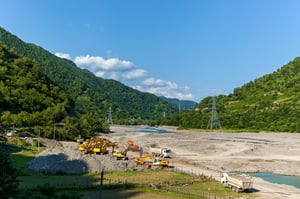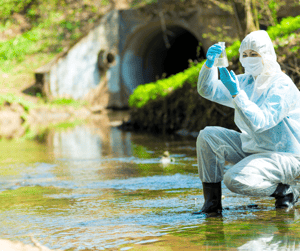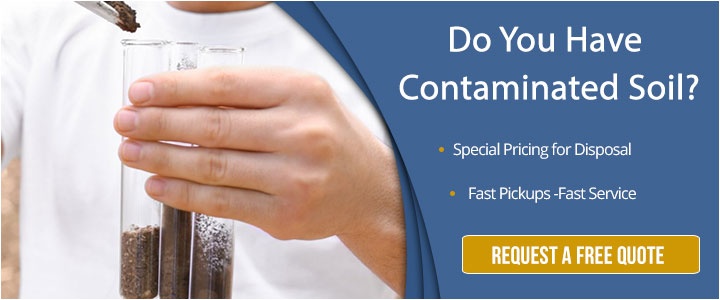As PFAS contaminated soil and waterways, the threat they pose to human and environmental health is becoming increasingly evident.
To combat PFAS contamination, the U.S. Environmental Protection Agency (EPA) has developed a strategic roadmap to address this pressing concern, and environmental laws concerning PFAS-contaminated soil are continuously evolving - driving the need for more proactive waste management practices.
Whether you’re a residential builder, construction company or business expanding your operations to a new site, you may come in contact with PFAS chemicals and require the safe disposal of PFAS-contaminated soil. Here’s what you need to know about these chemicals commonly found in everyday products and the danger they pose once they leach into the soil and our waterways.
What Are PFAS?
PFAS, or per- and poly-fluoroalkyl substances, are considered “forever chemicals.” Widely used across many industries, PFAS have components that are slow to break down over time.
industries, PFAS have components that are slow to break down over time.
Among the industrial applications where PFAS is used are aerospace, automotive, construction and electronics. They are also found in everyday items like:
- Water-resistant fabrics like rain jackets, umbrellas and tents
- Stain-resistant coatings that are used on carpeting, upholstery and other fabrics
- Grease-resistant paper
- Cleaning products
- Paints
- Fire-fighting foams
- Non-stick cookware
- Food packaging
- Food processing equipment
- Personal care products, including shampoo, dental floss, nail polish and eye makeup
They can even be found in food grown in contaminated soil and in meat products from livestock that consume these food products.
What Makes PFAS So Strong?
PFAS consist of a chain of linked carbon and fluorine atoms. This carbon-fluorine bond is extremely strong, and because of this, these chemicals do not degrade easily in the environment.
When products are discarded, PFAS waste can leach into agricultural fields and waterways, where it can be difficult to remove.
How Does Exposure To PFAS Happen?
While human exposure to these manmade chemicals is widespread, exactly how much a person is exposed can be based on a number of factors like geography and occupation.
based on a number of factors like geography and occupation.
For example, some common ways individuals are exposed to PFAS include:
- Drinking contaminated water (municipal or private well)
- Consuming fish with high levels of PFAS
- Consuming food grown in contaminated soil
- Eating food packaged in a material made with PFAS
- Swallowing contaminated soil or dust
- Using consumer products that are made with PFAS
Babies born to mothers who have been exposed to PFAS can be exposed themselves, whether it’s during pregnancy or while breastfeeding, according to the U.S. Centers for Disease Control.
Some types of workers are at particular risk as well, including chemical manufacturing workers, firefighters, service sector workers and ski wax technicians.
Why Is Proper Disposal Of PFAS Contaminated Soil Important?
PFAS bioaccumulation can occur both in humans and non-human organisms. When PFAS accumulates in fish, for example, chemicals eventually end up in people when they consume the food. Protecting the environment from PFAS contamination not only benefits animals and plant life, it benefits human health as well.
PFAS are considered endocrine disruptors. This means they interfere with a human’s hormone system, which can lead to changes in the body and brain. This can then lead to diseases and health issues, researchers say, including liver and thyroid problems, reproductive issues, kidney and testicular cancer and increased risk of birth defects.
When soil contamination occurs, proper disposal is key to prevent further contamination in groundwater and surface water, perpetuating the contamination and affecting much larger areas. When PFAS-contaminated soil releases these chemicals into nearby water bodies, including rivers, lakes and aquifers, this poses a risk to drinking water sources for communities downstream.
Soil particles from PFAS-contaminated soil can also inadvertently be deposited on crops and then enter the food chain through grazing animals. Proper transportation and disposal of contaminated soil can help minimize this risk.
If you're a construction company or operate another type of business like food manufacturing that has unearthed PFAS-contaminated soil, another important reason to secure proper transportation is to comply with regulations.
As we’ll discuss later in this article, environmental regulations are constantly evolving, and it’s critical to make sure your business is doing its part to protect the environment and the public so that you can avoid costly fines.
How Is PFAS Contaminated Soil Commonly Disposed Of?
Excavation and off-site disposal or treatment is a common method for disposing of PFAS-contaminated soil. What happens to the soil once it is transported off-site often depends on the quantity of impacted soil.
For example, some landfill operators are restricting large amounts of PFAS-containing waste to protect themselves against future liability. Some states, including California, consider PFAS as a hazardous substance, which could restrict which landfills would accept this type of contaminated soil.
Another option for disposal is in-situ stabilization. The thermal treatment method moves contaminants in soil using heat. During this heating process, contaminants are destroyed. Stabilization uses fixation agents in the subsurface as well to entrap contaminants and to prevent them from leaching into groundwater.
What Do I Need To Know About PFAS Laws?
As we mentioned above, environmental laws revolving around PFAS-contaminated soil and groundwater are evolving. There are also a number of research efforts underway that could shape future laws involving PFAS.
In 2021, the U.S. Environmental Protection Agency developed a PFAS Strategic Roadmap that lays out the agency’s approach to addressing PFAS through 2024. The roadmap sets timelines to take specific actions and enact new policies to protect public health and the environment, as well as hold polluters accountable.
Earlier this year, the EPA issued an Advance Notice of Proposed Rulemaking, which asks for public input regarding any potential future hazardous substance designations of PFAS under the Comprehensive Environmental Response, Compensation and Liability Act (CERCLA), also known as Superfund.
This request for input follows the agency’s proposed rule in 2022 to designate two types of PFAS, perfluorooctanoic acid (PFOA) and perfluorooctanesulfonic acid (PFOS), and their sales and structural isomers, as hazardous substances.
Among other initiatives, the EPA also added five PFAS in 2022 to a list of risk-based values for site cleanups. These Regional Screening Levels and Regional Remedial Management Levels help the organization determine if response or remediation activities are needed at contaminated sites.
As further changes to environmental laws come down the pipeline, it’s important for your business to be prepared. You may even find yourself dealing with hazardous waste laws for the first time.
How Can A Disposal Company Help?
If you’re a company that manufactures products that contain PFAS or a business that excavates sites and must test for soil contamination, it’s important to get prepared for any upcoming changes in waste disposal requirements.
Working with certified hazardous waste disposal companies can help you feel confident that you are meeting all current AND future regulations. The most experienced waste disposal companies regularly monitor pending legislation and initiatives from agencies like the EPA to help you prepare for how these laws will impact your business.
Being proactive in your waste management practices is not only responsible but necessary to ensure you aren’t scrambling to secure proper waste disposal or finding yourself on the wrong end of the law.
Because landfill requirements and remediation processes are constantly changing, it’s helpful to work with a disposal company that is familiar with local Treatment, Storage and Disposal Facilities (TSDF) and what each accepts. Quality disposal companies will also transport your contaminated soil beyond your community - even as far as out of state - to ensure your disposal process is legal and as seamless as possible.
The best disposal companies will also offer the ability to identify waste streams through profiling and testing - especially important if you do not know whether contamination is present - as well as a walk-through program to evaluate your waste procedures. This program is especially important as laws evolve because it is consultative in nature and will help you better understand how any upcoming legislation may impact your waste procedures.
Other services that hazardous waste disposal companies offer include:
- Transportation of your waste to the recycling or disposal site that accepts your type of waste
- Evidence that your waste has been properly destroyed or disposed of
- Provided documentation that is required for transport, including manifests
Just as the EPA has developed a roadmap to reduce PFAS contamination in soil and waterways and the threat that both pose to human and environmental health, a quality disposal company will help you develop your own roadmap. This roadmap will include a comprehensive plan for the safe and responsible disposal of PFAS-contaminated soil, tailored to your specific needs and compliance requirements.


Comment